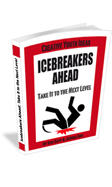Description
Have you ever tried to change someone? To shape someone into your idea of a perfect husband, a perfect child, a perfect parent? Do our expectations of others in the group help them or hinder them?
Resources
Camera (Optional)
Preparation
Divide the group into pairs. One person is the “Sculptor” and one is the “Statue”
What to Do
- If participants already know each other, then without talking, the “Sculptor” must position the “statue” into a pose that best illustrates how he or she sees the other person or to illustrate that person’s place or contribution to the group. If participants don’t know each other well, have them pose the “statue” into a role or characteristic that is important to the growth and well being of the group.
- Have each pair work in front of the entire group. Take photos of each “Statue” when the sculptor is finished.
- After the statue has been positioned and a photo has been taken, the “statue” must try to explain to the group, what quality he or she thinks the sculptor is trying to illustrate and explain what they think it means to the rest of the group. Verify with the sculptor what was intended.
- If you have time, ask the pair to switch roles and do it again.
Taking it to the Next Level
We usually have specific expectations of other people. We have an image in our mind of how they should act, the things they should do, and the characteristics they possess. We may even try to shape them according to our expectations of what they should be. But most of the time it simply doesn’t work. Very soon they go back to their old self, leaving both frustrated.
Debrief
- How did you feel when your partner was trying to change you?
- When you were a sculptor, how did you feel when your statue changed position from what you intended?
- Did you understand what the person was trying to change in you? Why or why not?
- What were some of your frustrations – from both sides of the situation?
- How could you have been more effective?
Discussion
- What are some of the positions or roles that we have in our group? Make a list.
- What should a person in each role or position do? What characteristics should they possess?
- Do you ever feel like others are trying to change you? What are some of the things you think other people are trying to change about you? How does this make you feel?
- Have you ever tried to change another person? What were the results?
- Would the results be different if you modeled for them what you would like them to become? What if you tried to inspire them rather than force them? What is the most effective means by which we can bring about change in another person’s life? Is force sometimes necessary? If so, how do you know how much force to apply? How do you insure that the change is lasting?
Application
Pick one trait that you would like to see in others in the group and choose to model that in YOUR OWN LIFE! The only person you can truly change is yourself.
Possible Scripture References
Paul Instructed Timothy to “be an example to the believers…” – 1 Timothy 4:12. The word for “example” that Paul used comes from the Greek word “tupos” and is used in the sense of being a pattern, an example, for others to follow. Its like a mold that you can press the clay into so that it takes that same shape. Its like a loom that guides the threads for the weaving. Its like the painter’s masterpiece that his students are inspired to imitate. It’s a physical or visual reference so that you know how something should look when it is completed and that can be used to guide progress. Each of these illustrates, with varying degrees of pressure, the importance of a pattern or an example for others to shape their lives. Christ is that same example for all of us. By God’s grace, one day we might all be able to say as Paul said, “Imitate me as I imitate Christ.” “Follow my example as I follow the example of Christ!” “Follow me to the extent that I follow Christ” (1 Corinthians 11:1)
 Icebreakers Ahead: Take It To the Next Level
Icebreakers Ahead: Take It To the Next Level
This 170 page resource not only provides 52 of the world’s most popular group icebreaker activities and games, but also includes lesson ideas and discussion questions to smoothly transition into conversations about the issues common to most groups.
Click here to find out how to get your hands on this incredible resource!
